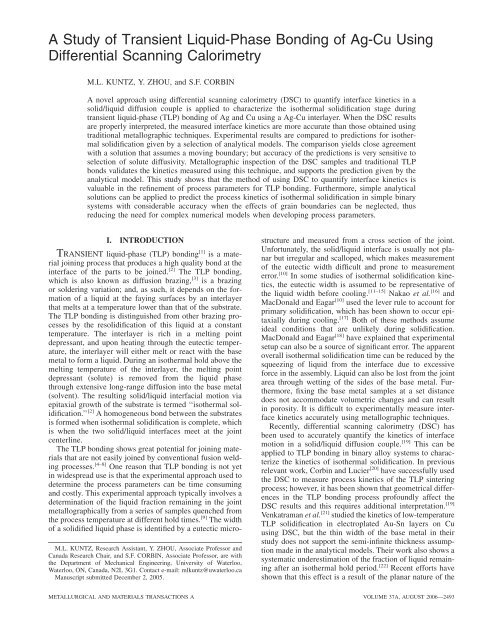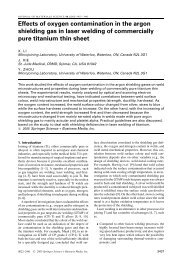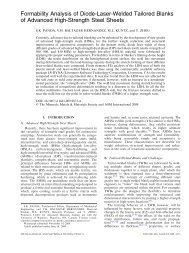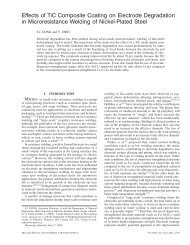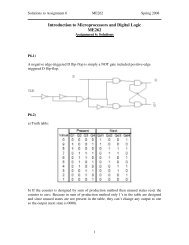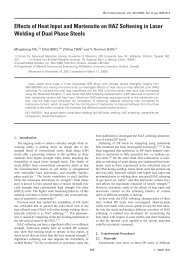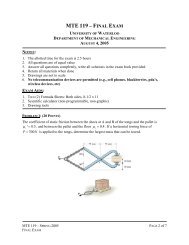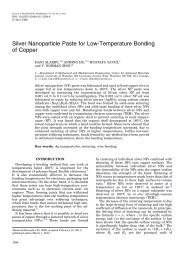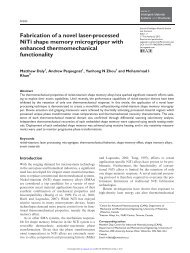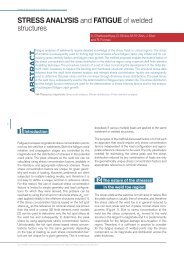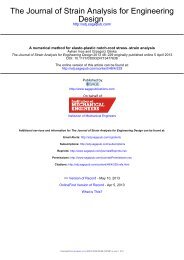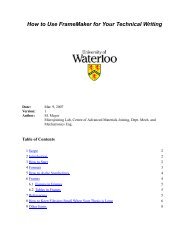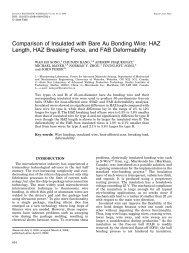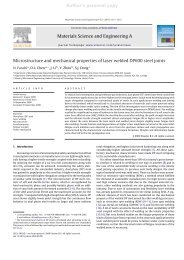A Study of Transient Liquid-Phase Bonding of Ag-Cu Using ...
A Study of Transient Liquid-Phase Bonding of Ag-Cu Using ...
A Study of Transient Liquid-Phase Bonding of Ag-Cu Using ...
You also want an ePaper? Increase the reach of your titles
YUMPU automatically turns print PDFs into web optimized ePapers that Google loves.
and can be assumed zero. Specific information regarding theDSC experimental setup is given in the account <strong>of</strong> previouswork. [19]Adynamic nitrogen atmosphere was used in the DSC forall trials. The initial heating rate was 40 ° C/min. At 700 ° C,the heating rate was reduced to 10 ° C/min for enhancedmeasurement resolution and reduced thermal lag in thetemperature range <strong>of</strong> interest. The bonding temperaturewas 800 ° C. The isothermal hold time at the bonding temperaturewas varied from zero to the time required for isothermalsolidification to near completion. Thecooling cyclewas opposite the heating cycle.The DSC measures heat flow <strong>of</strong>the sample relative to areference cell during heating or cooling. Heat flow ismeasuredusing apair <strong>of</strong> thermocouples that compare the temperaturechange <strong>of</strong> reference and sample cells. Thus, theDSC is capable <strong>of</strong> studying the kinetics <strong>of</strong> thermal events,such as phase changes. Experimental results are given inthe form <strong>of</strong> aDSC trace, which shows the heat flow <strong>of</strong>athermal event as either endothermic or exothermic peaks( i.e. ,melting or solidification, respectively). The integral <strong>of</strong>the peak is ameasure <strong>of</strong>the enthalpy <strong>of</strong> the event, andwhen an isothermal hold time is inserted between the heatingand cooling <strong>of</strong> aTLP-bonded sample, aratio <strong>of</strong> theexotherm to the endotherm is an indication <strong>of</strong> the amount<strong>of</strong> liquid remaining, which traditionally has been foundusing metallographic examination.The heating and cooling segments at 10 ° C/min, whichpass through the melting temperature <strong>of</strong> the <strong>Ag</strong>-<strong>Cu</strong> eutecticfoil ( i.e., 780 ° C), are the segments used to quantify isothermalsolidification. This portion <strong>of</strong> the DSC trace isplotted inFigure 5as afunction <strong>of</strong>heat flow vs temperature.Integration <strong>of</strong> the melting or solidification peaksgives the total energy <strong>of</strong> the thermal event. Since the composition<strong>of</strong> the liquid is constant throughout the isothermalsolidification stage, the heat <strong>of</strong> formation <strong>of</strong> the liquid, D h fwill remain unchanged. Thus, the ratio <strong>of</strong> the solidificationendotherm, D H s ,tothe melting exotherm, D H f ,will be theamount <strong>of</strong> liquid remaining at the termination <strong>of</strong> the isothermalhold period (Eq. [2]).fraction <strong>of</strong> liquid remaining 5 c D H sD H f[2]where the constant, c ,isexperimentally determined for thesystem. [19]The correction isrequired due to asystematic underestimation<strong>of</strong> the residualliquid in the results that is related tothe effects <strong>of</strong> the TLP half-sample geometry. First, baselineshift on the DSC trace during initial dissolution <strong>of</strong> the foilincreases the measured enthalpy <strong>of</strong> melting. [19] The thermalcontact resistance atthe interlayer/base-metal interface isreduced as liquid wets the faying surface, which causes ashift in the baseline across the endothermic melting peak.Second, epitaxial solidification <strong>of</strong> aprimary phase at thesolid/liquid interface upon cooling from the bonding temperatureto the eutectic temperature reduces the measuredenthalpy <strong>of</strong> solidification. [19] The exothermic solidificationpeak includes only the enthalpy <strong>of</strong> eutectic solidification;primary epitaxial growth <strong>of</strong> the solid phase is not measuredin this arrangement. These effects can be quantified using amodified temperature program and are constant as isothermalsolidification progresses. The effects <strong>of</strong> baseline shiftand primary solidification are included in the experimentallyderived constant (C ), which is multiplied with the enthalpyratiotoaccurately represent the fraction <strong>of</strong> liquid remaining.The interface position (Eq. [3]) can be calculated fromthe fraction <strong>of</strong> liquid remaining (Eq. [2]) using the theoreticalmaximum liquid width, given by Eq. [4].X ð t Þ 51 ÿ c D H sD H fB. Metallurgical Examination W max2[3]W max ¼ C F W 0C L a[4]The DSC half-samples were sectioned and mounted in abakelite resin. The samples were polished to 1 m musing adiamond suspension. The samples were then etched usinga20mLNH 4 OH, 20mLH 2 O 2 ,and 10 mL H 2 Osolution.The solid/liquid interface region was inspected using opticaland scanning electron microscopy. Acomposition pr<strong>of</strong>ile <strong>of</strong>the <strong>Cu</strong>inthe <strong>Ag</strong> base metal was obtained using aspot EDSanalysis at measured intervalsfromthe solid/liquid interface.Fig. 5—Melting and solidification peaks onDSC trace <strong>of</strong>TLP half-sample.IV.RESULTS AND DISCUSSIONA. Analytical Models for Isothermal SolidificationThe experimental results are compared toanalytical predictionsfor solid/liquid interface motion. Two models aretaken from the literature, while athird is derived subsequently.Themodelscan give widely varying results dependingon process conditions. Tuah-Poku et al. [27] suggestedthat the kinetics predicted by analytical models do not agreewell with the experimental observations. For the derivation<strong>of</strong> the analytical models, the review article by Zhou et al.2496—VOLUME 37A, AUGUST 2006METALLURGICAL AND MATERIALS TRANSACTIONS A
should be referenced. [2] In this study, the isothermal solidificationstage is treated asadiscrete stage in the TLP bondingprocess. The following assumptions are made in thederivation: nosolute is lost tothe base metal before theisothermal solidification stage begins; solute distribution inthe liquid is uniformthroughout the stage; [24] the solid/liquidinterface is at equilibrium; the solid/liquid interface movementis planar; and the base metal substrate width issemiinfinitewhen compared tothe interlayer width.Asimple solution for the total time required for isothermalsolidification ( t s )can be found by assuming asolutecomposition pr<strong>of</strong>ile based on astationary solid/liquid interface.The isothermal solidification time is found by equatingthe total solute content in the liquid to the interface fluxintegrated over the isothermal hold period. The solution isgiven by Eq. [5]. [27]t s ¼p C F W 20[5]16 D s C a L ÿ C 0The composition solution is based on the assumption thatthe solid/liquid interface is stationary with respect to thebase metal. Amore rigorous treatment <strong>of</strong> the problem treatsthe solid/liquid interface as a moving boundary. Ikawaet al. [9] present asolution for the moving interface problemby assuming that the concentration pr<strong>of</strong>ile <strong>of</strong> the solute inthe base metal has the same form as the stationary case,except with ashifting reference frame that is fixed to thesolid/liquid interface. The position <strong>of</strong> the solid/liquid interfaceis given by Eq. [6]. [16]X ð t Þ 5 C 0 ÿ C a LC L a ÿ C a L 2 r ffiffiffiffiffiffiffiffiffiffiD s tpThe time required for completion <strong>of</strong> isothermal solidificationcan be found when the solid/liquid interface reachesthe joint centerline, given by Eq. [7].t s ¼p16 D s[6]C F W 0 C L a ÿ C 2a L[7]C L a C 0 ÿ C a LThe result (Eq. [7]) isvery similar to the solution for astationaryinterface (Eq.[5]); and,althoughthere is an assumption<strong>of</strong> a moving boundary, it does not account for thesweeping action <strong>of</strong> the solid/liquid interface as it advancestoward the centerline. Atheoretically accurate account <strong>of</strong>the movinginterface wasfirstgiven by Lesoult. [28] Asimilarsolution derived subsequently follows the work <strong>of</strong> Maugiset al. [29] on biphase diffusion couples. This solution wasfirst applied toTLP bonding bySinclair [30] in work on multicomponentsystems. A substitution variable, l , givenby Eq. [8] is substituted into Fick’s second law toyieldEq. [9].l ¼ p x ffiffi [8]tÿ l 2 dCd l 5 D d 2 Cd l 2 [9]The boundary condition on Eq. [9] is C ( j ) 5 C a L ,wherethe rate constant, j ,isdefined by the interface ( i.e., l i 5 j ).It can be easily shown that Eq. [10] is asolution <strong>of</strong> theordinary differential equation. lerfc p ffiffiffiffi2 DC ð l Þ 5 C a L [10]jerfc p ffiffiffiffi2 DThe position <strong>of</strong> the solid/liquid interface, X(t) can then bewritten by Eq. [11]. The parabolic nature <strong>of</strong> the interfaceposition is not an assumption, but rather aproperty <strong>of</strong> theexact solution.p ffiffiX ð t Þ 5 j t[11]The mass balance given by Eq. [12] can be used to find theinterface rate constant, j ,and the time required for completion<strong>of</strong> the isothermal solidification stage, where k is apartition coefficient given by C L a / C a L .Equation [13] mustbe solved numerically to find the constant, j .C a L ðk ÿ 1jÞ p2 ffiffi t5 D dC p 1 ffiffi [12]d l l ¼ j tr ffiffiffiffi exp ÿ j 2 j ¼ÿ2 ðk ÿ 1 Þ ÿ 1 D 4 D p j [13]erfc p2 ffiffiffiffiDThe significance <strong>of</strong> the interface rate constant, j ,isthat it isan indication <strong>of</strong> the isothermal solidification rate. Increasingj results in faster solid/liquid interface motion andshorter duration <strong>of</strong> the isothermal solidification stage. Furthermore,j is independent <strong>of</strong> the initial liquid width; thus,it is useful to discuss process kinetics in terms <strong>of</strong> j ratherthan the time required for isothermal solidification whenthe temperature and initial liquid width are varied.The isothermal solidification stage is complete when thesolid/liquid interface reaches the joint centerline; the timerequired is given by Eq. [14].t s ¼ÿ W 2max[14]2 jIt is interesting to note that this solution gives the sameresult as asimilar method derived by Danckwerts [31] andused by Lesoult, [28] which is described in detail by Zhouet al. [2] It is thought that the solution presented here issomewhat simpler in derivation.B. Predicted and Experimentally MeasuredInterface KineticsThe results <strong>of</strong> the DSC diffusion couple experimentfor the <strong>Ag</strong> base metal with the eutectic interlayer held at800 ° Care given in Figure 6. As expected, the fraction <strong>of</strong>METALLURGICAL AND MATERIALS TRANSACTIONS A VOLUME 37A, AUGUST 2006—2497
Fig. 8—Fraction <strong>of</strong> liquid remaining in TLP half-sample after isothermalhold time. The <strong>Ag</strong> base metal with 24 pct-<strong>Cu</strong> interlayer bonded at 800 ° C.Fig. 9—Fraction <strong>of</strong> liquid remaining in TLP half-sample after isothermalhold time. The <strong>Ag</strong> base metal with 10 pct-<strong>Cu</strong> interlayer bonded at 880 ° C.intuitive since the diffusivity is expected to increase withincreasing temperature. The effective diffusivity for thissystem is found to be D eff 5 6.4 3 10 ÿ 9 cm 2 /s based onthe kinetic measurements. This is an entire order <strong>of</strong> magnitudehigher than the effective diffusivity found for thediffusion couples held at 800 ° C, which is not unreasonablegiven the increase in T b from 800 ° Cto880 ° C; however,the value is higher than expected using the available diffusiondata. Once again, caution must be exercised in usingdiffusion data that was collected under different conditionsthan the application.If <strong>Cu</strong> is substituted for the base metal using a<strong>Ag</strong>-<strong>Cu</strong>eutectic interlayer and an 800 ° Cisothermal hold temperature,the resulting isothermal solidification kinetics areshown in Figure 10. The resulting interface kinetics giveFig. 10—Fraction <strong>of</strong> liquid remaining in TLP half-sample after isothermalhold time. The <strong>Cu</strong> base metal with 25-m m-thick eutectic <strong>Ag</strong>-<strong>Cu</strong> interlayerbonded at 800 ° C.pan interface rate constant <strong>of</strong> j 95ÿ 0 : 019 m m = ffiffi s and aneffective diffusivity <strong>of</strong> D eff 5 3.3 3 10 ÿ 10 cm 2 /s. The interfacekinetics with the <strong>Cu</strong> base metal and eutectic interlayerare significantly lower than that measured with the <strong>Ag</strong> basemetal. This isdue in part to the lower effective diffusivity,but more to the significantly higher partition coefficient( i.e., 11.1 compared to2.4) at the <strong>Cu</strong>-rich end <strong>of</strong> the phasediagram. It is obvious why this experiment was not carriedout to completion since the predicted time required forcompletion <strong>of</strong> isothermal solidification is 574 hours.The results in Figure 10 are compared tothe isothermalsolidification kinetics observed by MacDonald and Eagar [10]in Table III. The <strong>Cu</strong>-base metal was TLP bonded using a101-m m-thick eutectic <strong>Ag</strong>-<strong>Cu</strong> interlayer atp 820 ° C. Aninterface rate constant <strong>of</strong> j 95ÿ 0.056 m m = ffiffi s was foundby measuring the eutectic width, although these results werefound to be erroneous, due in part to difficulty in determiningthe liquid width across the entire joint area. MacDonaldand Eagar measured the area under composition pr<strong>of</strong>iles<strong>of</strong> <strong>Ag</strong> in <strong>Cu</strong> to relate the liquid width to solute diffusedand found p better agreement with the prediction (j 5ÿ 0.021 m m = ffiffi s ,based on D eff 5 3.1 3 10 ÿ 10 cm 2 /s). Theseresults agree well with the DSC results, but this method isnot practical because integration <strong>of</strong> the composition pr<strong>of</strong>ilesis atedious process requiring many measurements.D. Effect <strong>of</strong> Grain BoundariesIt has been widely reported that grain boundaries providean enhanced solute diffusion path that results in faster diffusionrates and irrigation <strong>of</strong>the base metal. [2,8,10,36] Thiseffect has been shown to be negligible in the <strong>Ag</strong>-<strong>Cu</strong> systemat temperaturesabove 700 ° Cinacoarse-grained basemetalwhere there are few grain boundaries to enhance diffusion.[32] Furthermore, at temperatures greater than 80pct<strong>of</strong> the melting point, the difference between the bulk andgrain boundary diffusivities becomes smaller, reducinggrain boundary effects. It has been shown through both2500—VOLUME 37A, AUGUST 2006METALLURGICAL AND MATERIALS TRANSACTIONS A
Table III. Comparison <strong>of</strong> Experimental Interface KineticsMeasured using DSC and Traditional Techniques for<strong>Cu</strong>-Base MetalpEvaluation Technique T b ( ° C) j ð m m = ffiffi s ÞDSC method 800 ÿ 0.019Visual inspection [10] 820 ÿ 0.056Concentration pr<strong>of</strong>ile integration [10] 820 ÿ 0.021experimental and numerical work that the effects <strong>of</strong> grainboundaries onthe nature <strong>of</strong>solid/liquid interface motion arevaried. Fine-grained base metal samples show grain boundarygrooving and spherical protrusions causing asignificantdeviation from the planar solid/liquid interface. [10]Coarse-grained substrates show less deviation from the planarmorphology. [37] The isothermal solidification time isreduced significantly with fine-grained base metal; the differencein isothermal solidification rates between coarsegrainedand single-crystal base metal isnegligible. [10,37,38]The increase in interface kinetics with finer grain size hasbeen attributed toenhanced grain boundary diffusion andgrain boundary grooving, although support for this theoryby numerical modeling has onlybeenqualitativetodate. Onthe other hand, for coarse-grained substrates bonded athigher temperatures and longer isothermal hold times, ithas been shown that the effect <strong>of</strong>grain boundaries on solid/liquid interface motion is much less significant and can beconsidered with aneffective diffusivity if required. [10,36,39]Zhou et al. [2] point out that the interface kinetics duringthe isothermal solidification stage can be estimated using ananalytical solution as long as the effects <strong>of</strong> grain boundariescan be neglected. When the grain size islarge, the bondingtemperature approaches the base metal melting point, andthe isothermal hold time is long, the effect <strong>of</strong> grain boundarieson the process kinetics is minimized, and the analyticalsolution can be applied. Inthis study, the processkinetics <strong>of</strong> isothermal solidification as measured using DSChave been accurately predicted using an analytical solutionwith published diffusion data. Any grain boundary effectsare fully included in the assumed diffusivity.E. Metallurgical AnalysisAcross section <strong>of</strong>aTLP half-sample shows aeutecticregion, atwo-phase region, and the single-phase base metal(Figure 11). The eutectic region (dark) is clearly shown inthe backscatter electron image in Figure 12. The interfacebetween the eutectic and the two-phase region is scallopedwith acusp that penetrates into the two-phase region <strong>of</strong> thebase metal. Previous work has shown that during coolingfrom the bonding temperature to the eutectic temperature,primary solidification <strong>of</strong> a -phase occurs epitaxially at thesolid/liquid interface. [19] The scalloped eutectic/base metalinterface is evidence <strong>of</strong> acellular solidification mode; however,the original liquid width (before cooling) is obscuredby the precipitate microstructure and cannot be measured.The two-phase region in Figure 11 clearly shows adiscontinuousstructure known as cellular precipitation, [40] whichoccurs during cooling. The reaction front, showninFigure 13,is a migrating grain boundary that facilitates growth <strong>of</strong>the precipitates by providing adiffusion path for solutepartitioning. [40]Fig. 11—Interface region <strong>of</strong> TLP-bonded half-sample after cooling. Threedistinct regions are apparent: the solidified eutectic, atwo-phase regionwhere cellular precipitation has occurred in the solid state, and the unaffectedbase metal. [19]Fig. 12—Backscatter electron image <strong>of</strong> the interface region showing theeutectic and base metal <strong>of</strong> aTLP half-sample after cooling.Fig. 13—Solid-state transformation region/base-metal interface showingthe migrating cellular precipitation front. Precipitates form upon coolingand obscure the underlying microstructure soprimary solidification cannotbe observed.The concentration <strong>of</strong> <strong>Cu</strong> was measured at intervals perpendicularlyinto the base metal from the interface <strong>of</strong> theeutectic microstructure. To account for primary a -phasesolidification, the concentration data has been shifted bysome amount to get better agreement with the predictedMETALLURGICAL AND MATERIALS TRANSACTIONS A VOLUME 37A, AUGUST 2006—2501
pr<strong>of</strong>ile. The actual distance that the data were shifteddepends on the extent <strong>of</strong> primary solidification and thereference point that was chosenalongthe eutectic interface.Since this interface was scalloped, there is no uniform distancefrom the reference point to the original solid/liquidinterface. The shifted concentration pr<strong>of</strong>iles are showngraphically in Figure 14 and agree well with those predictedby the moving interface model. At shorter distancesfrom the interface, there is significant noise inthe measurementscaused bythe cellular precipitation microstructure.As the distance from the interface increases past the cellularprecipitation reaction front, the measured concentrationpr<strong>of</strong>ile becomes smooth and agrees fairly well with thepredictions, with points systematically lying slightly abovethe curve. This could be due to variations in the diffusivitywith concentration along the pr<strong>of</strong>ile. Amanual error inshifting the experimental curve for primary solidificationwill also contribute to the difference.F. TLP Full SamplesThe TLP full-sample joints were produced with a25- m m-thick <strong>Ag</strong>-28 wt pct <strong>Cu</strong> foil interlayer. The joints wereprepared in a similar manner to the DSC experimentTLP half-samples. The DSC traces <strong>of</strong> these samples arenot <strong>of</strong> interest since the thick base metal between the jointand the measuring thermocouples dampens heat flow tothe point that it cannot be measured. Cross sections <strong>of</strong>theTLP bonds with increasing isothermal hold times areshown inFigure 15. After 1hour atthe bonding temperature,a uniform layer <strong>of</strong> eutectic remains at the jointinterface. Increasing the hold time to 2hours results inathin and broken eutectic layer. The eutectic region isreduced to sparse and irregular pockets after 3hours andhas completely disappeared after 4hours. Based on therate constant experimentally p measured with the DSC, i.e .,j 5 ÿ 0.126 m m = ffiffi s ,the expected time required for completionis 3.9 hours. Thus, the rate constant predicted bythe DSC shows good agreement with the metallographicresults. It would be very difficult to accurately measurethe process kinetics using visual inspection to estimatethe liquid width, especially if isothermal solidificationwas not taken to completion. This elucidates that theDSC method provides an accurate quantification <strong>of</strong>theinterface kinetics during isothermal solidification wheretraditional metallographic techniques have failed.Fig. 14—<strong>Cu</strong> concentration pr<strong>of</strong>iles measured after ( a )2h, ( b )4h, ( c )8h, and ( d )12h.<strong>Ag</strong>base metal with eutectic <strong>Ag</strong>-<strong>Cu</strong> interlayer bonded at 800 ° C.2502—VOLUME 37A, AUGUST 2006METALLURGICAL AND MATERIALS TRANSACTIONS A
Fig. 15—TLP-bonded samples after ( a )1h, ( b )2h, ( c )3h, and ( d )4h. As expected, the width <strong>of</strong> the cellular precipitation region increases with time due toincreasing penetration <strong>of</strong> solute in the base metal. The <strong>Ag</strong> base metal with 25-m m-thick eutectic <strong>Ag</strong>-<strong>Cu</strong> interlayer bonded at 800 ° C.V. CONCLUSIONSAmethod using DSC to quantify interface motion in asolid/liquid diffusion couple has been used to accuratelycharacterize the process kinetics <strong>of</strong> the isothermal solidificationstage in TLP bonding. The measured interfacekinetics are proportional to the squareroot <strong>of</strong> the isothermalhold time and can be compared with analytical predictions.Metallographic techniques have been used to validate theDSC results.1. The measured interface rate constants for the <strong>Ag</strong>-<strong>Cu</strong>system p with <strong>Ag</strong> base metal at 800 ° C were ÿ 0.126m m = ffiffi p ffiffis and ÿ 0.128 m m = s for the eutectic and <strong>Ag</strong>-24wt pct <strong>Cu</strong>interlayers, respectively. These values agreewell with the interface rate constant predicted byamovinginterface solution.2. The stationary interface solution overestimates the timerequired for isothermal solidification by apredictableamount. The shifting reference solution systematicallyunderestimates the time for isothermal solidification toreach completion.3. The accuracy <strong>of</strong> analytical model predictions is pr<strong>of</strong>oundlydependant upon the accuracy <strong>of</strong> relevant chemicaldiffusion data. When reliable data are available, theisothermal solidification kinetics given by the movingboundary model are useful in developing TLP bondingprocess parameters.4. The interface kinetics measured using the DSC methodhave been shown to be more accurate than traditionalmethods, which involve manual estimation <strong>of</strong> the eutecticwidth using optical microscopy <strong>of</strong> metallographicsamples. Thus, the DSC method is avaluable tool tobe used alongside analytical modeling in the developmentand refinement <strong>of</strong> process parameters for TLPbonding.ACKNOWLEDGMENTSThis study has been supported by Materials and ManufacturingOntario, an Ontario Centre <strong>of</strong> Excellence; and theNatural Science and Engineering Research Council.REFERENCES1. D.S. Duvall, W.A. Owczarski, and D.F. Paulonis: Welding J ., 1974,vol. 53, pp. 203-14.2. Y. Zhou, W.F. Gale, and T.H. North: Int. Mater. Rev., 1995, vol. 40,pp. 181-96.3. Welding Handbook, 8th ed., L.P. Connor, ed., American Welding Society,Miami, FL, 1989, vol. 1.4. K. Nishimoto, K. Saida, D. Kim, and Y. Nakao: Iron Steel Inst. Jpn.Int., 1995, vol. 35, pp. 1298-306.5. M.S. Yehand T.H. Chuang: Welding J ., 1997, vol. 76 (12), pp. 517s-21s.6. J.P. Jung and C.S. Kang: Mater. Trans., JIM, 1996, vol. 37, pp. 1008-13.7. W.D. MacDonald and T.W. Eagar: in The Metal Science <strong>of</strong> Joining,M.J. Cieslak, J.H. Perepezko, S.Kang, and M.E. Glicksman, eds.,TMS, Warrendale, PA,1992, pp. 93-100.8. J.E. Ramirez and S. Liu: Welding J ., 1992, 71, 10, pp. 365s-75s.9. H. Ikawa, Y. Nakao, and T. Isai: Trans. Jpn. Welding Soc., 1979, vol.10, pp. 25-29.METALLURGICAL AND MATERIALS TRANSACTIONS A VOLUME 37A, AUGUST 2006—2503
10. W.D. MacDonald and T.W. Eagar: Metall. Mater. Trans. A,1998, vol.29A, pp. 315-25.11. Y. Nakao, K. Nishimoto, K. Shinozaki, and C. Kang: Trans. Jpn.Welding Soc., 1989, vol. 20, pp. 60-65.12. T.H. North, K. Ikeuchi, Y. Zhou, and H. Kokawa:in The Metal Science<strong>of</strong> Joining, M.J. Cieslak, J.H. Perepezko, S. Kang, and M.E.Glicksman, eds., TMS, Warrendale, PA,1992, pp. 83-91.13. A. Sakamoto, C. Fujiwara, T. Hattori, and S. Sakai: Welding J ., 1989,vol. 68, pp. 63-71.14. A. LeBlanc and P. Mevrel: Proc. Conf. ‘‘High Temperature Materialsfor Power Engineering II,’’ E. Bachelet, R. Brunetaud, D. Coutsouradis,P. Esslinger, J.Ewald, I. Kvernes, Y. Lindblom, D.B. Meadowcr<strong>of</strong>t,V. Regis, R.B. Scarlin, K. Schneider, and R. Singer, eds., Dordrecht,The Netherlands, 1990, pp. 1451-60.15. J.P.Jung and C.S. Kang: Mater.Trans., JIM,1997, vol.38, pp. 886-91.16. Y. Nakao, K. Nishimoto, K.Shinozaki, and C.Y. Kang: in Joining <strong>of</strong>Advanced Materials, T.H. North, ed., Chapman and Hall, London, 1990,pp. 129-44.17. K. Saida, Y. Zhou, and T.H. North: J. Jpn. Inst. Met., 1994, vol. 58, pp.810-18.18. W.D. MacDonald and T.W. Eagar: Annu. Rev. Mater. Sci., 1992, vol.22, pp. 23-46.19. M.L. Kuntz, S.F. Corbin, and Y. Zhou: Acta Mater., 2005, vol. 53, pp.3071-82.20. S.F. Corbin and P. Lucier: Metall. Mater. Trans. A,2001, vol. 32A, pp.971-78.21. R. Venkatraman, J.R. Wilcox, and S.R. Cain: Metall. Mater. Trans. A,1997, vol. 28A, pp. 699-706.22. S.R. Cain, J.R. Wilcox, and R. Venkatraman: Acta Mater., 1997, vol.45, pp. 701-07.23. J.T.Niemannand R.A. Garrett: WeldingJ., 1974, vol. 53 (4), pp. 175s-84s.24. H. Nakagawa, C.H. Lee, and T.H. North: Metall. Trans. A ,1991, vol.22A, pp. 543-55.25. W.F. Gale and D.A. Butts: Sci. Technol. Weld. Joining, 2004, vol. 9,pp. 283-300.26. P.R. Subramanian and J.H. Perepezko: in ASM Handbook,vol.3, Alloy<strong>Phase</strong> Diagrams, H.Baker, ed., ASM INTERNATIONAL, MaterialsPark, OH, 1992, p. 2.28.27. I. Tuah-Poku, M. Dollar, and T.B. Massalski: Metall. Trans. A ,1988,vol. 19A, pp. 675-86.28. G. Lesoult: Center for Joining <strong>of</strong> Materials Report, Carnegie MellonUniversity, Pittsburgh, PA,Sept. 1976.29. P. Maugis, W.D. Hopfe, J.E. Morral, and J.S. Kirkaldy: Acta Mater.,1997, vol. 45, pp. 1941-54.30. C.W. Sinclair: J. <strong>Phase</strong> Equilibrium, 1999, vol. 20, pp. 361-69.31. P.V. Dankwerts: Trans. Faraday Soc., 1950, vol. 46, pp. 701-12.32. J.R. Cahoon and W.V. Youdelis: AIME Met. Soc. Trans., 1967, vol.239, pp. 127-29.33. E.A. Brandes: in Smithells Metals Reference Book, 6th ed.,Butterworth and Co., London, 1983, pp. 13.9-13.54.34. Y. Zhou: J. Mater. Sci. Lett., 2001, vol. 20, pp. 841-44.35. Y. Zhou, M.L. Kuntz, and S.F.Corbin: Proc. Conf.Materials Solutions’02,ASM International, Materials Park, OH, October 7–9, 2002, 2003,pp. 75-82.36. Y. Zhou and T.H. North: Acta. Metall. Mater., 1994, vol. 42 (3), pp.1025-29.37. H. Kokawa, C.H. Lee, and T.H. North: Metall. Trans. A ,1991, vol.22A, pp. 1627-31.38. K. Saida, Y. Zhou, and T.H. North: J. Mater. Sci., 1993, vol. 28, pp.6427-32.39. K. Ikeuchi, Y. Zhou, H. Kokawa, and T.H. North: Metall. Trans. A ,1992, vol. 23A, pp. 2905-15.40. D.A. Porter and K.E. Easterling: <strong>Phase</strong> Transformations inMetals and Alloys, 2nd ed., Chapman and Hall, London, pp.322-26.2504—VOLUME 37A, AUGUST 2006METALLURGICAL AND MATERIALS TRANSACTIONS A


